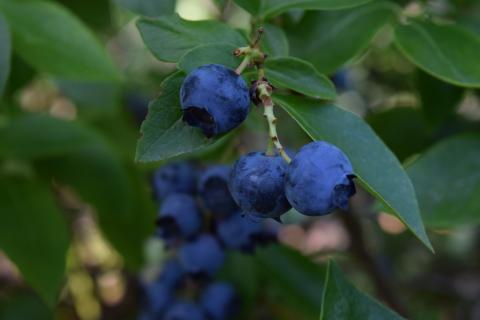Which blueberry varieties should I plant in my backyard?

Highbush blueberries are an important native fruit crop in New Hampshire. In their natural habitat, highbush blueberries are usually found growing along wetland margins. In home yards and garden blueberries grow best in well-drained soils that are high in organic matter. Sites that receive full-sun all day long promote maximum fruit production. Most importantly, blueberries need an acidic soil with a pH between 4.5 and 5.0 in order to grow well. If the soil pH is too high the leaves may yellow and the plants will likely fail to grow. Unaltered NH soils will often provide the necessary pH for blueberries, but it’s worthwhile to conduct a soil test to determine pH before planting. Soils with a pH above 5.0 can be amended by applying ground sulfur, but only apply at the rate recommended by a soil test.
Winter hardiness is perhaps the most important consideration in selecting blueberry varieties. New Hampshire’s cold winters and short growing season make blueberries that are listed as very hardy and ripen early or midseason good choices. In the southern half of New Hampshire, Blueray, Bluecrop, Patriot, Earliblue, Jersey, and Meader can be expected to perform well. Some highbush x lowbush blueberry hybrids such as Northland, Northblue, and St. Cloud are even cold hardier and are good choices for northern New Hampshire. A complete list of blueberry varieties can be found in the publication ‘Blueberry Varieties for New Hampshire.’
In selecting varieties, home blueberry growers should be aware of an insect pest called spotted wing Drosophila (SWD). SWD is a small gnat from China and Japan that infests the ripe and ripening fruit of blueberries (as well as many other types of fruit). Since SWD usually isn’t detected in NH until early July, early maturing varieties may be at less risk and are a good choice for home gardens.
Spring is a great time to plant young blueberry plants while soils are moist and temperatures are mild. Planting holes should be dug no less than twice as wide as the blueberry’s root ball. Incorporate a small amount of peat moss into backfill to increase soil organic matter. Cover the root zone with 3 to 4 inches of organic mulch such as wood chips, leaves, or pine needles to protect roots and help conserve soil moisture. Blueberries are extremely sensitive to drying out, so plants should be kept well-watered throughout the growing season, particularly during their first season as they become established.
Got questions? The Ask UNH Extension Infoline offers practical help finding answers for your home, yard, and garden questions. Call toll free at 1-877-398-4769, Monday to Friday, 9 a.m. to 2 p.m., or e-mail us at answers@unh.edu.
Related Resource(s)
Do you love learning about stuff like this?
SUBSCRIBE TO Granite State Gardening newsletter
Got questions? The UNH Extension Yard and Garden Infoline offers practical help finding answers for your yard and garden questions.
Call toll free at 1-877-398-4769, Monday to Friday, 9 a.m. to 2 p.m., or fill out webform.
